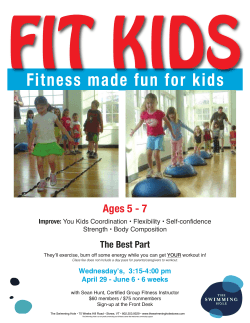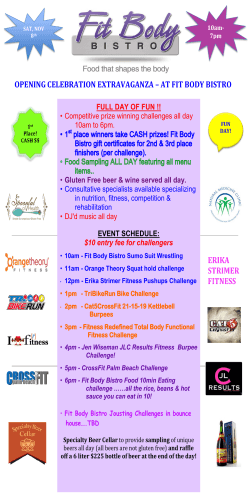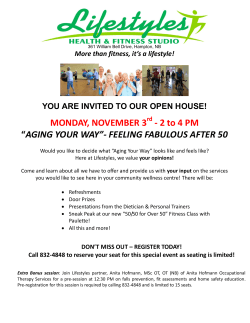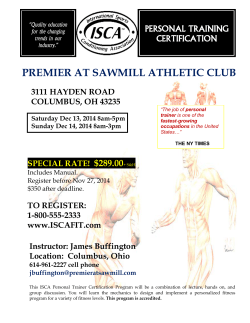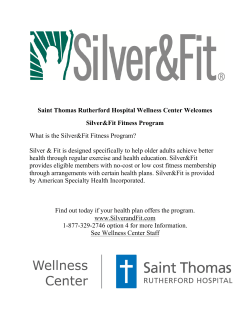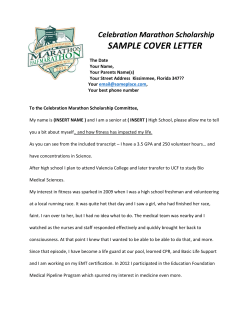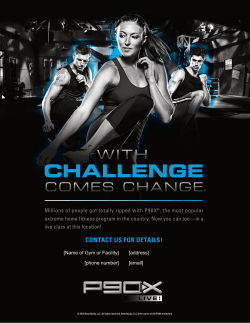
Gym Instructor Course Guide
Gym Instructor Course Guide Thank for you your interest in the Gym Instructor course with Amac. Within this course guide, you will find information on the different parts of the course and working as a fitness instructor. If you need further information then visit our website or ring 01227 831 840 or via email on [email protected] . Course Package Gym Instructor Pre requisites Over 16 Objectives of Course By the end of the course, you will have the knowledge, understanding and skills to plan and instruct gym-based exercise. The content reflects what an individual needs to know in order to function effectively as a gym instructor. Qualification Units Anatomy and Physiology for Exercise (mandatory) Health, Safety and Welfare in a Fitness Environment (mandatory) Principles of Exercise, Fitness and Health (mandatory) Know How to Support Clients Who Take Part in Exercise and Physical Activity (mandatory) Planning Gym-Based Exercise Instructing Gym-Based Exercise Note: There are 4 mandatory units to the Certificate in Fitness Instruction, this is the same for disciplines in gym, ETM, Aqua or Children’s instructor certificates. These four units are studied online. Certification Upon completing the Gym Instructor course with Amac, you will receive the following certification: Central YMCA Qualification Level 2 Certificate in Fitness Instruction (Gym) 01227 831 840 www.amactraining.co.uk Gym Instructor Job Profile The work They supervise customers using the facility, and ensure that they are exercising safely and effectively. They may conduct group exercise classes such as circuit training, aerobics or spinning. Hours and environment Full-time fitness instructors normally work 38-40 hours a week, often on a shift and rota basis to cover early mornings, evenings and weekends. Many people work part-time or on a freelance basis. Instructors work in environments including gyms, leisure centres and hotels. Some may work in clients' homes as personal trainers. Skills and interests To be a fitness instructor you should: have good communication skills and an outgoing and approachable personality be diplomatic and tactful have patience and the ability to motivate and enthuse people from a wide range of backgrounds have a responsible attitude to health and safety be informed about nutrition and a healthy diet. Entry To be employed as a qualified instructor and obtain public liability insurance you must be aged 18 or over. You will need nationally recognised qualifications at level 2, which will enable you to gain entry on to the Register of Exercise Professionals (REPs), also known as the 'exercise register'. Courses are offered by a range of providers, both colleges and private training providers, but you should check that these lead to a recognised qualification. Opportunities Gyms and fitness centres are located all over the UK, in both urban and rural areas. There has been a big increase in leisure facilities in recent years, leading to an increased demand for instructors, but there is still strong competition for jobs. Annual income Figures are intended as a guide only. Fitness instructors may start on a salary of around £12,000 with experienced personal trainers earning around £30,000. Adapted from Skillsactive. 01227 831 840 www.amactraining.co.uk Level 2 Anatomy and Physiology Course Information Introduction This unit covers the knowledge an instructor needs about basic anatomy and physiology relating to exercise programming for apparently healthy adults of all ages. Format This is an online theoretical part of the course which is one of the four accredited units of the qualification. You will receive log in details to Learnstream so that can start learning straight away. If you book online, this is emailed minutes after you have booked. Content Understand the structure and function of the circulatory system You will be able to: Identify the location of the heart Describe the function of the heart Describe how blood moves through the four chambers of the heart Describe the systemic and pulmonary circulation Describe the structure and functions of blood vessels Define blood pressure Identify blood pressure classifications Understand the structure and function of the respiratory system You will be able to: Identify the location of the lungs Describe the function of the lungs Describe the structure of the lungs Identify the main muscles involved in breathing Describe the passage of air through the respiratory tract Describe the process of gaseous exchange of oxygen and carbon dioxide in the lungs Describe the effects of age, pregnancy and disability on the cardiovascular and respiratory systems Understand the structure and function of the skeleton You will be able to: Describe the basic functions of the skeleton Identify the structures of the axial skeleton Identify the structures of the appendicular skeleton Describe the structure and function of the spine and the range of possible 01227 831 840 www.amactraining.co.uk Level 2 Anatomy and Physiology Course Information Content continued.. Explain the classification of bones Explain the structure of long bone Explain the stages of bone growth Understand joints in the skeleton You will be able to: Describe the classification of joints Describe the structure of synovial joints Describe the types of synovial joints and their range of motion Describe joint movement potential and joint actions Understand the muscular system You will be able to: Identify the three types of muscle tissue Define the characteristics and functions of the three types of muscle tissue Describe the basic structure of skeletal muscle Identify how muscles attach to the skeleton Name and locate the anterior skeletal muscles Name and locate the posterior skeletal muscles Describe the structure and function of the pelvic floor muscles Describe the different types of muscle action Identify skeletal muscle fibre types and their characteristics Identify the joint actions brought about by specific muscle group contractions Describe factors affecting the muscular system for age, pregnancy and disability Understand the life-course of the musculoskeletal system and its implications for special populations exercise You will be able to: Describe the life-course of the musculoskeletal system, including bone, and its implications for working with different client groups. Understand energy systems and their relation to exercise Describe how carbohydrates, fats and proteins are used in the production of energy Explain the use of the three energy systems during aerobic and anaerobic respiration Describe the effects of age, pregnancy and disability on the energy systems 01227 831 840 www.amactraining.co.uk Level 2 Anatomy and Physiology Course Information Content Continued Understand the nervous system and its relation to exercise You will be able to: Describe the role and functions of the nervous system Describe the principles of muscle contraction Describe the ‘all or none law’/motor unit recruitment Describe how exercise can enhance neuromuscular connections and improve motor fitness Assessments Externally set and assessed theory test in the form of a multiple choice written theory paper, externally set and marked by CYQ. The time allocation for the theory paper is 50 minutes. The time allocation for the theory paper is 50 minutes. The theory paper will comprise of 40 questions where learners must achieve a minimum of 28 marks overall to pass. When you are ready to sit the exam, call or email and you will be advised on what dates and venues are available. There is also a mock paper that can be attempted to help you decide if you are ready for the exam. Certification (Mandatory Unit 1) Anatomy and physiology for exercise (This unit is part of the Certificate in Fitness Instruction) 01227 831 840 www.amactraining.co.uk Level 2 Working in the Fitness Environment Course Information Introduction This aim of this unit is to provide the learner with the knowledge and understanding that instructors need to maintain health, safety and welfare in a variety of fitness environments, including the safeguarding of children and vulnerable adults. Format This is an online theoretical part of the course which is one of the four accredited units of the qualification. You will receive log in details to Learnstream so that can start learning straight away. If you book online, this is emailed minutes after you have booked. Content Health, Safety and Welfare in a Fitness Environment cover the following: Understand emergency procedures in a fitness environment Understand health and safety requirements in a fitness environment Understand how to control risks in a fitness environment Understand how to safeguard children and vulnerable adults Assessments Assessment 1 – Worksheet Learners are required to complete the Health, Safety and Welfare in a Fitness Environment worksheet successfully. This can be completed as part of a course or as part of summative assessment. Learners are required to achieve a minimum of 70% of total marks in order to pass this worksheet. Certification (Mandatory Unit 2) Health, Safety and Welfare in a Fitness Environment (This unit is part of the Certificate in Fitness Instruction) 01227 831 840 www.amactraining.co.uk Level 2 Principles of Exercise Course Information Introduction This unit covers knowledge an instructor needs to programme safe and effective exercise for a range of clients, the health benefits of physical activity and the importance of healthy eating. Format This is an online theoretical part of the course which is one of the four accredited units of the qualification. You will receive log in details to Learnstream so that can start learning straight away. If you book online, this is emailed minutes after you have booked. Content Principles of Exercise, Fitness and Health cover the following: Understand the effects of exercise on the body Understand the components of fitness Understand how to apply the principles and variables of fitness to an exercise programme Understand the exercise contraindications and key safety guidelines for special populations Understand how to safely monitor exercise intensity Understand the health benefits of physical activity Understand the importance of healthy eating Assessments Assessment Element 1: Theory Paper Externally set and assessed theory test in the form of a multiple choice written theory paper, externally set and marked by CYQ. Questions will relate to the underpinning knowledge listed for the Level 2 Principles of Exercise, Fitness and Health. The time allocation for the theory paper is 50 minutes. The theory paper will comprise of 40 questions where learners must achieve a minimum of 28 marks overall to pass. Certification (Mandatory Unit 3) Principles of Exercise, Fitness and Health (This unit is part of the Certificate in Fitness Instruction) 01227 831 840 www.amactraining.co.uk Level 2 Supporting Clients Course Information Introduction This unit covers the learner’s ability to have the necessary knowledge and skills required to communicate with their clients effectively, and motivate their clients to adhere to an exercise programme. Learners will apply the knowledge and skills they have learned to provide a more client focused approach to their training. Format This is an online theoretical part of the course which is one of the four accredited units of the qualification. You will receive log in details to Learnstream so that can start learning straight away. If you book online, this is emailed minutes after you have booked. Content Know How to Support Clients Who Take Part in Exercise and Physical Activity cover the following: Understand how to form effective working relationships with clients Understand how to address barriers to exercise that clients experience Understand how to support clients to adhere to exercise Understand how to provide ongoing customer service to clients Assessments Assessment 1 – Worksheet Learners are required to successfully complete the Client Communication and Motivation worksheet. This can be completed as part of a course or as part of the summative assessment. Learners are required to achieve a minimum of 70% of total marks in order to pass this worksheet. Certification (Mandatory Unit 4) Know How to Support Clients Who Take Part in Exercise and Physical Activity (This unit is part of the Certificate in Fitness Instruction) 01227 831 840 www.amactraining.co.uk Level 2 Gym Planning and Instructing Course Information Introduction This unit covers the skills and knowledge required to plan and prepare a gym-based exercise programme with apparently healthy adults of all ages along with other groups that are 14-16, disabled, pre/post natal and older adults that aren’t part of a large group. Format This is covered on a 4 day course when you will be given a comprehensive manual. You will receive details of the course dates and times that you booked onto, along with a timetable. Content Planning Gym-Based Exercise Understand how to collect client information to plan gym-based exercise Understand how to use client information to plan gym-based exercise Understand how to plan gym-based exercise with clients Be able to collect and use client information to plan a gym-based exercise programme Be able to plan a safe and effective gym-based exercise programme with clients Instructing Gym-Based Exercise Understand how to provide gym-based exercise Be able to prepare self and equipment for gym-based exercise Be able to prepare clients for gym-based exercise Be able to instruct gym-based exercise Be able to supervise clients undertaking gym-based exercise Be able to bring a gym-based exercise session to an end Be able to reflect on providing gym-based exercise Be able to support clients taking part in gym-based exercise Assessment (Overview) Students will be assessed by direct observation in Assessment Element 1 and Assessment Element 3 performing a total of: 3 CV machines 4 resistance machine exercises 4 free weight exercises 3 body weight exercises 01227 831 840 www.amactraining.co.uk Level 23 Gym Programming Planning and and Instructing Delivering Course Information Assessments Assessment Element 1 Continuous assessment (direct observation) 2 free weight exercises 2 resistance machine exercises 3 body weight exercises 1 CV machine Spotting Assessment Element 2 Session planning Session overview Aims, objectives, and health and safety considerations Gym programme card For a gym session, including: A warm up component A CV component 4 resistance machine exercises 4 free weight exercises 3 body weight exercises Cool down component Assessment Element 3 Summative practical session (direct observation) (Based on the gym programme card from Assessment Element 2) A warm up component Mobility and pulse raising on CV machine Preparatory stretch – static or dynamic A CV component 2 resistance machine exercises 1 planned, 1 assessor choice 2 free weights 1 planned, 1 assessor choice Cool down component Flexibility including developmental stretching Assessment Element 4 Reflecting on gym-based exercise Self evaluation Certification (Units) Planning Gym-Based Exercise (This unit is part of the Certificate in Fitness Instruction (Gym)) Instructing Gym-Based Exercise (This unit is part of the Certificate in Fitness Instruction (Gym)) 01227 831 840 www.amactraining.co.uk
© Copyright 2025
